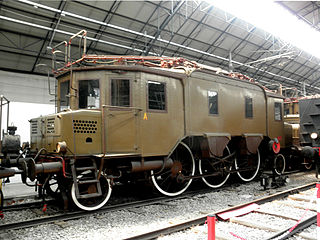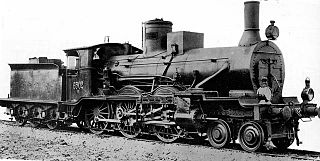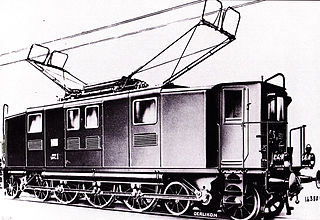This article needs additional citations for verification .(July 2016) |
| Class E.550 | |||||||||||||||||||
|---|---|---|---|---|---|---|---|---|---|---|---|---|---|---|---|---|---|---|---|
 | |||||||||||||||||||
| |||||||||||||||||||
| |||||||||||||||||||
| |||||||||||||||||||
| |||||||||||||||||||
The FS Class E.550 was a class of three-phase electric locomotive used in Italy, introduced in the 20th century, which remained in service until 1965.
This article needs additional citations for verification .(July 2016) |
| Class E.550 | |||||||||||||||||||
|---|---|---|---|---|---|---|---|---|---|---|---|---|---|---|---|---|---|---|---|
 | |||||||||||||||||||
| |||||||||||||||||||
| |||||||||||||||||||
| |||||||||||||||||||
| |||||||||||||||||||
The FS Class E.550 was a class of three-phase electric locomotive used in Italy, introduced in the 20th century, which remained in service until 1965.
In the wake of the success met by three-phase electric locomotives on the Valtellina line, in the early 20th century the newly formed state-owned Ferrovie dello Stato, led by Riccardo Bianchi, decided to electrify the important mountain line of the Giovi Pass as well, which connected the port of Genoa to the industrial cities of northern Italy. The decision was taken because the line was close to full saturation despite the use of the powerful 470 class steam locomotives. Electrification of the line at 3,400V, 15.8 Hz [1] was completed in 1916.
The designer of the electric part was Hungarian engineer Kálmán Kandó. The whole project, initially developed by the FS central design studio, was later completed by the Società Italiana Westinghouse of Vado Ligure. The first E.550 prototype proved capable of hauling trains of up to 400 t (390 long tons; 440 short tons) at 50 km/h (31 mph) on the steep hill stretches of the Giovi railroad. In comparison, a pair of Class 470 steam locomotives were only capable of 310 t or 310 long tons or 340 short tons at half that speed. The use of electric traction solved the problem of smoke dissipation in the tunnels as well. A total of 186 E.550s were built between 1908 and 1921, in four series.

E.550 had five axles connected to the two electric motors through an articulated coupling rod. The three center axles were rigidly mounted to the frame and the center axle's wheels were without flanges. The outer axles were mounted in a manner that allowed them to turn into curves. The wheels were small, and thus adapted to heavy freight or slow passenger services at low speed. The locomotive had two cabs, one at each end of the central compartment. The motors were asynchronous three-phase, which could be connected in series at low speed and in parallel at higher speeds. The connections were enabled through a drum switch using a liquid-cooled rheostat. Feeding was provided by paired trolley poles at each end, each pair carrying two bow collectors for the two wires of the three phase system.
Braking was provided by an automatic continuous brake and a regulated, hand-operated brake.

The locomotives of classes E.551, E.552 and E.554 were all developments of E.550. Some E.550s units were later transformed into snow-sweepers.
In 1953, locomotive E.550.023 was modified at Bolzano to add a large snow plow to one end. It served on the Brenner line from 1955 to 1965.
In 1955, locomotives E.550.086 and E.550.115 were demotorized and transformed into push-type snow plows; they received the classification Vnx 201 and 202. Between 1963 and 1966 additional units were transformed in the same fashion to become Vnx 210–222. Sometime thereafter, snow plow equipped E.550.023 was also demotorized.
At some point, the Vnx were renumbered into the series Vnx 806.210-222. Some have since been renumbered into the 12-digit UIC scheme in the series 40 83 970 6 0xx-x.
E.550.025 is at the National Museum of Transportation in St. Louis, Missouri, in poor cosmetic condition due to being stored outside since 1968. It is awaiting transfer to Savigliano (CN), Italy, in the exhibition of the Piedmont Railway Museum. There is an ongoing fundraiser for its transfer by sea. [2]
E.550.030 is at the Museo Nazionale Scienza e Tecnologia Leonardo da Vinci in Milan, Italy.

The Turin–Genoa railway line is a major Italian rail line, connecting the cities of Turin and Genoa. It is 169 kilometres (105 mi) long.

Three-phase AC railway electrification was used in Italy, Switzerland and the United States in the early twentieth century. Italy was the major user, from 1901 until 1976, although lines through two tunnels also used the system; the Simplon Tunnel between Switzerland and Italy from 1906 to 1930, and the Cascade Tunnel of the Great Northern Railway in the United States from 1909 to 1939. The first standard gauge line was in Switzerland, from Burgdorf to Thun, from 1899 to 1933.

The FS Class E.330 was a small class of three-phase electric locomotive used in Italy, introduced in the 1910s.

The Ferrovie dello Stato Class 685 is a class of 2-6-2 'Prairie' express train steam locomotives. These are colloquially known as Regine, mirroring their fame as one of the most successful and appreciated Italian steam locomotives.

The Ferrovie dello Stato Italiane Class 691 is a class of 4-6-2 'Pacific' locomotives; they were the fastest and most powerful locomotives ever built for the Italian railways.

The Ferrovie dello Stato Italiane Class 746 is a class of 2-8-2 'Mikado' steam locomotive. These were the biggest locomotives ever built by the Ferrovie dello Stato, even though not the fastest, which were the Class 691s.

The Ferrovie dello Stato Italiane Class 470 is a 0-10-0 steam locomotive.

The Ferrovie dello Stato Italiane Class 650, formerly SFAI1181-1200 and Rete Mediterranea 300 Class, also known as "Vittorio Emanuele II", was the first steam locomotive in continental Europe to have the 4-6-0 'Ten-Wheeler' arrangement.

The Ferrovie dello Stato Italiane Class 552, formerly Rete Adriatica Class 180 bis, is a 4-4-0 steam locomotive; it was the final development in Italy of the 'American' express locomotive type.

The Ferrovie dello Stato Italiane Class 835 is a 0-6-0T steam locomotive; it was the standard steam shunter of the FS.
A monomotor bogie is a form of traction bogie used for an electric locomotive or diesel-electric locomotive. It is distinguished by having a single traction motor on each bogie.

The FS Class E.430 locomotives, initially classed as RA 34, were three-phase alternating current electric locomotives of the Italian railways. They were built for Ferrovia della Valtellina by Ganz and MÁVAG in 1901 and had a power output of 440 kW and a haulage capacity of 300 tons. One locomotive is preserved.

The FS Class E.431 was a class of three-phase AC electric locomotives of the Italian State Railways (FS).

FS Class E.432 was a class of three-phase electric locomotives of the Italian State Railways. Forty of these 1′D1′ locomotives were built in 1928 by Società Ernesto Breda and two have been preserved.

FS Class E.332 was a class of three-phase electric locomotives of the Italian State Railways (FS). They were used for the haulage of passenger trains between 1917 and 1963. Designed and built at the same time as the FS Class E.331, they represented an attempt by FS to extend the use of three-phase AC electric traction from primary to secondary routes. Their performance was disappointing and they were relegated to a marginal role, in which they remained despite several modifications.

FS Class E.333 was a class of electric locomotives of the Ferrovie dello Stato (FS), powered by three-phase alternating current, which were in service from 1923 to 1968. They were designed by Kálmán Kandó for hauling fast passenger trains. Having the same electrical equipment as the FS Class E.552 locomotives, they presented the same defects and had to be modified. After modification, they were able to carry out the services for which they were designed.

FS Class E.321 was a class of 17 third-rail electric locomotives, built for the Italian State Railways (FS) for operation on the Varese line and on the underground line in Naples.

The Mastodonte dei Giovi was a special double steam locomotive built specifically for use on the difficult Apennine stretch of the new Turin - Genoa railway line, inaugurated in 1853.

FS Class 400 were steam locomotives of French construction, built for service in Italy. They were 0-8-0 tender locomotives with two outside cylinders.
The Trieste Campo Marzio Railway Museum is a museum in Trieste (Italy), concerned with railway and tram transportation. It is housed in Trieste Campo Marzio railway station, the former Trieste Staatsbahnhof during the Austro-Hungarian period and one of the two main terminal stations in Trieste. Since July 2017, the museum has been closed for renovation by the Fondazione FS.